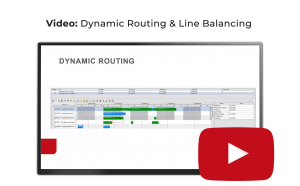To achieve optimal efficiency and productivity, manufacturers strive to minimize downtime. While an ideal outcome would involve no problems and zero downtime, the reality is that many factors can interrupt production. The key, then, is for manufacturers to be able to quickly turn a production issue into a solution. How can manufacturers access speedy resolution of potential production problems? Through knowledge and full visibility of the entire production line — the kind of transparency that a robust manufacturing execution system (MES) can provide. With MES, manufacturers can combine dynamic routing and line balancing to effectively reduce problems and prepare for any production delays.
Dynamic routing makes manufacturing more nimble
 Complex manufacturing processes involve numerous production flows or routes. These routes are the paths that individual manufacturing components travel in order to become the final product in a production line. Process management, a key MES function, aims to optimize these routes. A dynamic route is one that changes, or which can be changed when necessary. Dynamic routing is essential to a more agile approach to the complex steps in the manufacturing process.
Complex manufacturing processes involve numerous production flows or routes. These routes are the paths that individual manufacturing components travel in order to become the final product in a production line. Process management, a key MES function, aims to optimize these routes. A dynamic route is one that changes, or which can be changed when necessary. Dynamic routing is essential to a more agile approach to the complex steps in the manufacturing process.
For example, in the event that the equipment producing a single component of a product is down, dynamic routing can guide the manufacturing process to ensure that an alternate process can be followed. Part of this solution involves moving from unidirectional to multidirectional flows. MES applications allow for modeling complex flows to ensure successful plant operation. Also, MES applications communicate the necessary data to ensure that a manufacturer has full visibility of all process flows, no matter how complex the environment becomes.
Line balancing ensures that production rate aligns with demand
In complex manufacturing, it’s crucial to balance operator and machine time with the rate at which the end product needs to be produced. Line balancing helps manufacturers align these manufacturing times to avoid bottlenecks, underproduction or excess capacity. While the considerations in line balancing differ from those in dynamic routing, the goal is the same: ensuring efficiency through optimal resource use.
Line balancing reduces idle time from unsynchronized operations, and since waiting time is one of the eight wastes of lean manufacturing. In addition, line balancing helps regulate production so manufacturers can more easily and effectively respond to changes, in a similar manner that dynamic routing makes manufacturers more agile.
Both dynamic routing and line balancing help manufacturers overcome changes in resources and planning needs in order to ensure full production mode. These methods also help manufacturers reach key metrics goals of overall equipment effectiveness (OEE).
Objective International is an MES that empowers manufacturers with the tools for an effective response to external and internal supply chain and logistic changes. For more information on Objective, view our video on Dynamic Routing and Line Balancing. To ensure easy planning and scheduling of available resources to keep your plant running optimally, contact us for more information.


